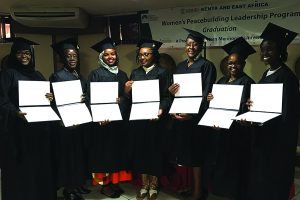
THEY ARE INSPIRING.
- Georgia Molia-Hanna is the first woman to hold a government peacebuilding position in Papua New Guinea.
- Amina Abdulkadir was awarded the 2017 Woman Peacebuilders for Water Award, honoring women working to resolve water-related conflicts. Classmate Naema “Nimo” Somo was a finalist among eight others in the inaugural international award offered by Milan Global and the Milan (Italy) Center for Food Law and Policy.
- Fatuma Abass ran for public office in Kenya. So did Maryam Abdikadir.
- Violet Muthiga developed an impactful project focused on the re-integration of a group of mothers who had been ostracized from their community after their sons were arrested on terrorism charges at a local mosque.
The work of these graduates and others from the Women’s Peacebuilding Leadership Program is the inspiration for new innovation at CJP.
“Recent decreases in traditional funding opportunities that supported WPLP in the past have led us to focus on new innovations that build on the program’s strengths and empower its alumni,”said Daryl Byler, CJP executive director. “It’s important for the CJP community to know that while we have not identified funders to continue WPLP in its current configuration, the success of program graduates and the contributions of those who supported them here at CJP is the basis for future cohort-based peacebuilding training in a different format.”
WHAT COULD THIS NEW PHASE OF COHORT-BASED EDUCATION LOOK LIKE?
• WPLP graduates and their organizations create a wide network and strong foundation to develop and implement effective peacebuilding projects.
In contrast to top-down project design and implementation, WPLP graduates, with their local knowledge and capacity to connect and empower, bolster the work and regional infrastructure that matters to specific communities and regions. CJP has relied successfully on graduates and their grassroots connections to identify areas of need and integrate their leadership and organizations into project implementation.
In Kenya, for example, WPLP graduates have advised on specific needs and topics related to a training and mini-grant program for youth-focused organizations, and their organizations have been integrated into the project’s future implementation.
• The program’s successful cohort model, in which participants learn and grow together through their coursework, has shown that building community among peacebuilders is just as important as each individual’s ongoing work.
A strong community of peacebuilders grows resilience, provides access to mentorship and resources, and inspires others. Participants in our cohort learning model often report that they feel more equipped, secure and empowered in the long-term because they can rely on other participants for advice, support and mentorship. Cohorts provide a problem-solving hub, allowing for frank discussion and lots of exchanging of ideas through the learning and implementation process. This collaborative, integrative model of community-building helps lay the groundwork for systemic change.
In Iraq, this model has been used successfully in youth peacebuilding leadership trainings and community projects, as well as with educators and administrators engaging with the potential for a national peacebuilding curriculum (see page 6).
Extending the cohort model to professional development and trainings, CJP staff can develop innovative combinations of curriculum on a range of topics to meet organizational needs.
• WPLP’s model can have impact in the United States – and WPLP graduates can help us create and implement new intervention models for diverse contexts.
Violet Muthiga’s work with ostracized mothers, for example, has direct application to diverse integration or re-integration projects in the United States. Her model – combining community education, counseling, mentoring, and trauma and resilience training – has the potential for application in other contexts: refugees and immigrants struggling to adapt to new cultures; residents in communities dealing with long-term conflict and/or misunderstandings; or mothers who want to use their experiences with family members to counter the effects of violent extremism, racism, or domestic violence through building resiliency in their families and communities.
With growing interest and coalition-building around important issues in the United States, there are many benefits to domestic deployment of the model that has empowered so many WPLP peacebuilders in other countries. With adaptable curriculum and a variety of online and face-to-face delivery options, a cohort focused on a specific topic could undergo training, followed by project-based practical application and leadership opportunities.
This could take shape in a variety of ways: A group from Appalachia could explore the effects of adverse childhood experiences through the lens of trauma and resilience and then collaborate on a specific project using their new knowledge and skills. Pastors could focus on conflict resolution and prevention. People working with youth could learn the basics of restorative justice to integrate into their organizational structure.
WHAT’S YOUR VISION?
Do you have an idea for a cohort-based project? (See pages 6 and 22 for examples of this model.)
Share your idea with Alena Yoder, CJP cohort projects coordinator: alena.yoder@emu.edu.